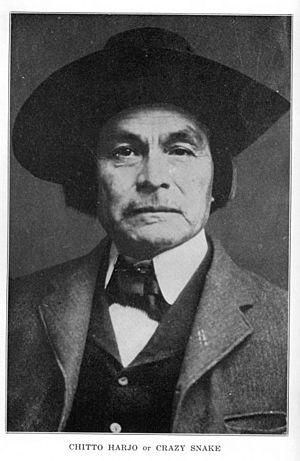Four Mothers Society facts for kids
The Four Mothers Society or Four Mothers Nation is a special group of Muscogee, Cherokee, Choctaw, and Chickasaw people, along with some Natchez people who are part of these tribes, living in Oklahoma. This group is religious, political, and focused on keeping old traditions alive. Even today, their special meeting places, called ceremonial grounds, are still used.
The society was started in the 1890s. Its main goal was to fight against new rules that wanted to divide up tribal lands. These rules were part of something called the Dawes Commission and other laws made by the US government. The Four Mothers Society was against dividing their shared lands because it went against their culture and way of life. They also worried that if the land was divided, some parts would be sold to people who were not Native American, causing them to lose their ancestral lands.
At its strongest, the Four Mothers Society had more than 24,000 members.
Contents
What is the Four Mothers Society?

The idea of the Four Mothers Societies might have existed for a long time, even before it was officially written down. It officially started as a group that collected membership fees around 1895 in Sulphur Springs, Indian Territory. It continued to be a legal group until at least 1915, and likely much longer.
The name "Four Mothers" is very important. Some believe it refers to the idea that Cherokee mothers come from Selu, the Corn Mother, who is a very important figure in their stories. The name might also refer to the four directions (North, South, East, West), which are very important in their religious beliefs and practices.
Why the Society Was Formed
In the late 1800s, the US government passed laws like the Curtis Act in 1898 and the Dawes Act. These laws made it government policy to divide up tribal lands. This meant that the land, which had been owned by the whole tribe, would be split into smaller pieces and given to individual families. The tribal governments were forced to agree to this, and people had to register to get their land.
Many members of the Four Mothers Societies were very upset about this. They believed that breaking up their shared lands would destroy their culture and traditions.
Leaders and Their Actions
Chitto Harjo was a Muscogee leader who strongly opposed the land division. He set up a new Muscogee government in Henryetta. Many Muscogee people who were against the land division saw Harjo's government as the true one.
In 1900, Harjo's followers held a meeting. They said that Pleasant Porter and his government had broken the 1867 Muscogee Constitution. They declared Porter's government invalid and named Harjo as the new principal chief.
Redbird Smith, another important traditional leader who started the Nighthawk Keetoowah Society, also became involved with the Four Mothers Society.
In 1906, the group sent a petition with 186 signatures to the US Congress. They wanted to send a group to Washington, D.C., to talk about broken treaties and their worries about the official tribal leaders. Harjo spoke to the Senate, supported by the Four Mothers Nation.
A Native American State
The Four Mothers Society was also connected to a movement that wanted to create a State of Sequoyah. Instead of joining with Oklahoma Territory and becoming part of the United States, they suggested creating a separate state just for Native Americans.
Keeping Traditions Alive
Besides openly fighting against the land division, the Four Mothers Societies also kept their traditions alive. They maintained special ceremonial grounds for important events like stomp dances, stickball games, feasts, meetings, and other ceremonies. In the late 1980s, the Chickasaw had at least one dance ground, and the Cherokee had another.
Today, in the early 21st century, several Four Mothers Society grounds are still active in eastern Oklahoma.
In Books and Stories
Author LeAnne Howe, who is from the Choctaw Nation of Oklahoma, mentions the Four Mothers Society in her novels. She writes about it in the context of traditional matriarchal culture, where women hold important roles. She explores this topic deeply in her book Miko Kings.
Related Topics

